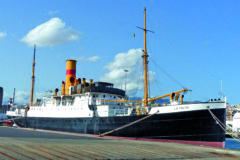Historic gallopers ride on!
Posted by Chris Graham on 16th March 2021
David Reed reveals the fascinating story behind the Howard Brothers’ 1886 historic gallopers ride that’s still going strong today.

Historic gallopers ride on!: The mounts have been painted by Gary Howard, with this horse being named Norman. However, names can change with the arrival of new grandchildren!
Nearly everybody likes a fun fair. In the 1960s, one of the highlights of my year was when the fair rolled into my home town of Northallerton, transforming the High Street for a couple of days each May and September. It was the lights, the colour and the excitement that provided the attraction; nothing could beat it!
It was also the complexity of the rides themselves that caught the imagination, and I spent many hours watching them being assembled before the fair actually opened. Now progress has decreed that the Waltzer, Noah’s Ark and rocket rides of my youth have mainly been replaced by attractions that rely on hydraulics to construct; the magic might still be there but not quite in the same way.
Still enjoyable
Of course, older rides can still be enjoyed, at museums such as Dingles Fairground Heritage Centre, in West Devon, but also at rallies up and down the country where, along with traction engines, a vintage fairground can be a major attraction.
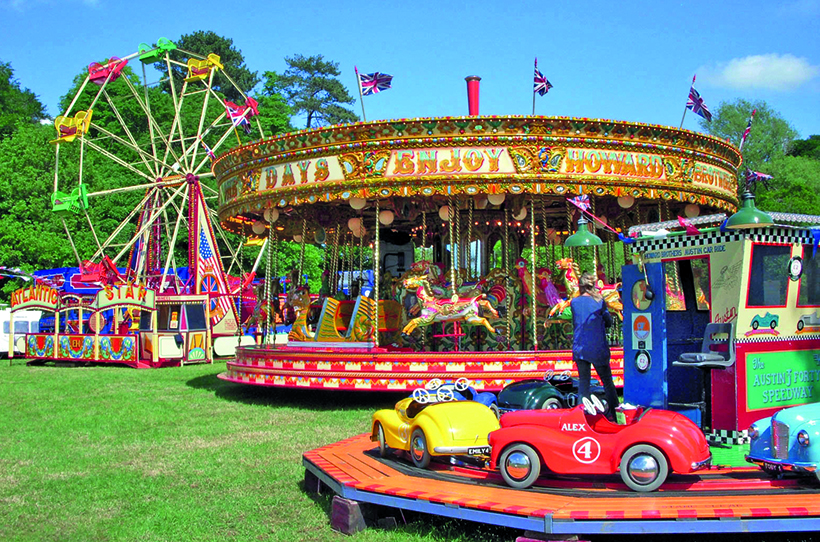
The Howard family’s rides together. The gallopers are seen in action with the vintage set of Austin cars that operate on a track in the foreground, and Edward’s big wheel behind.
Ian and Gary Howard have been associated with steam and vintage fairgrounds for many years, presenting their beautiful set of Savage gallopers at events up and down the county. They have an interesting history, and I recently met with Ian Howard and his partner, Linda Taylor, at their Derbyshire home, to talk about the Howard family story.
Their interest began with Ian and Gary’s father, Norman Cecil Howard, who was universally known as Ces. He owned Howard’s bakery in Cromford and, during his younger days, Harry Hall’s fair used to build-up outside the bakery. Ces would stand on the showman’s engines while they generated power for the rides. His favourite engine was Little Alf, a 7hp Fowler, which would pull the Wall of Death up Cromford Hill. It was these stories that Ces told Ian and Gary as small children that probably made them into the ‘Fowler’ men they are today.

Little Alf was Harry Hall’s 7hp Fowler showman’s engine which would pull the Wall of Death up Cromford Hill.
But it wasn’t just the love of the fairground that the boys were brought up with; steam was in their blood, too, as their parents took them to rallies from a very early age. Ces was instrumental in the founding of the Cromford Steam Rally, which was first held in 1970. And it was attending these steam rallies that sparked their interest after seeing the engines.
By the early 1970s, the boys were proud owners of an engine themselves. “While on holiday in Skegness, we bought a 1904 Marshall 6hp Compound roller (No. 40047), which we named Egar,” Ian told me. A few years later, we got a 1921 Marshall 5hp road locomotive (No 74871) called Lion, but it was always our goal to own a Fowler showman’s engine,” he added. Ces went on to buy a Dutch street organ that was fitted into a trailer, he loved fair organ music, and travelled the organ alongside Lion with Ian and Gary.
Engine purchase
Things moved on regarding the Marshall engines; in 1979, Ian, Gary and family were at The Great Dorset Steam Fair when they heard that a showman’s engine was coming up for sale. It turned out to be Renown, a 1920 Fowler showman’s R3 Special 8hp road locomotive (No.15653), that was owned by Ran Hawthorne. The engine was no stranger to the fairground either, having been ordered new by John Murphy in the north-east, and working with him until the late 1930s. Ian, Gary and family decided to go ahead with the purchase, and sold the Marshalls to fund the deal. With the engine in their possession, and after a two-year restoration process, Renown was displayed at numerous events around the country and abroad.
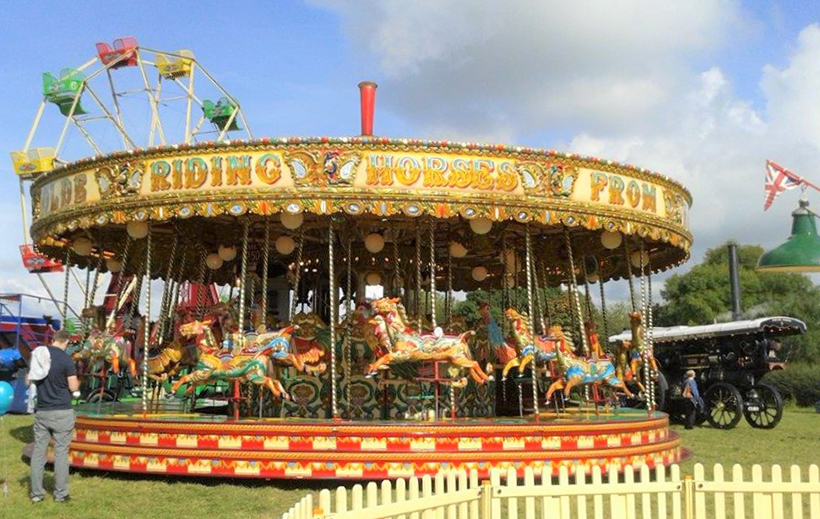
The Howard Brothers’ Savage gallopers are seen on a sunny day, with Eddie Howard’s Atlantic Star big wheel behind and the 18-ton, 1920, Fowler showman’s 8hp road locomotive (No. 15653), Renown, in the background.
While taking Renown over to an event in Holland, they met Fred Copeland and Harry Lee, who asked the boys to assist with putting-up and dismantling the famous Harry Lee Steam Yachts (which Fred had just purchased from Harry) using Renown. The idea was to do it ‘the old-fashioned way’, as Harry Lee would put it.
“Fred had a large collection of engines and fairground rides, and he asked if we’d take his set of gallopers to some fairs,” Ian said. It was an offer that they simply couldn’t refuse, and they started travelling the ride with him for a number of years. Fred and Rene became very good friends of the family. Eventually, though, Fred decided to sell the gallopers to Frank Lythgoe but, to Ian and Gary’s delight, Frank asked them to continue to travel the Gallopers. Frank and his family also became very good friends.
Ian and Gary decided that it was time to buy their own set of gallopers so, in 2004, they saw a set of Walker gallopers advertised on eBay, which were in Holland. A trip was organised to go and view them and a deal was agreed. Then, with the help of Dave Cope and Anthony Thompson (Swindlers Transport), a further trip was organised to bring them back to the UK.
No centre engine
“The only problem was that this set of gallopers hadn’t got a centre engine, and we wanted the ride to be steam-operated,” Ian explained. “I knew that Jimmy Noyce of London had a set of gallopers that had got a steam engine centre; he’d been restoring them for 12 years!” Despite only really wanting the centre for their Walker Gallopers, Ian decided to call Jimmy. “I asked him if he’d sell just the centre to us?” But he wasn’t prepared to do that, so it was the whole ride or nothing. That gave the brothers in a dilemma, as they’d already bought a set of gallopers. However, the offer was one that Ian and Gary just couldn’t refuse; it was a really good Savage set that had been built in 1886 so, in the end, they snapped his hand off!
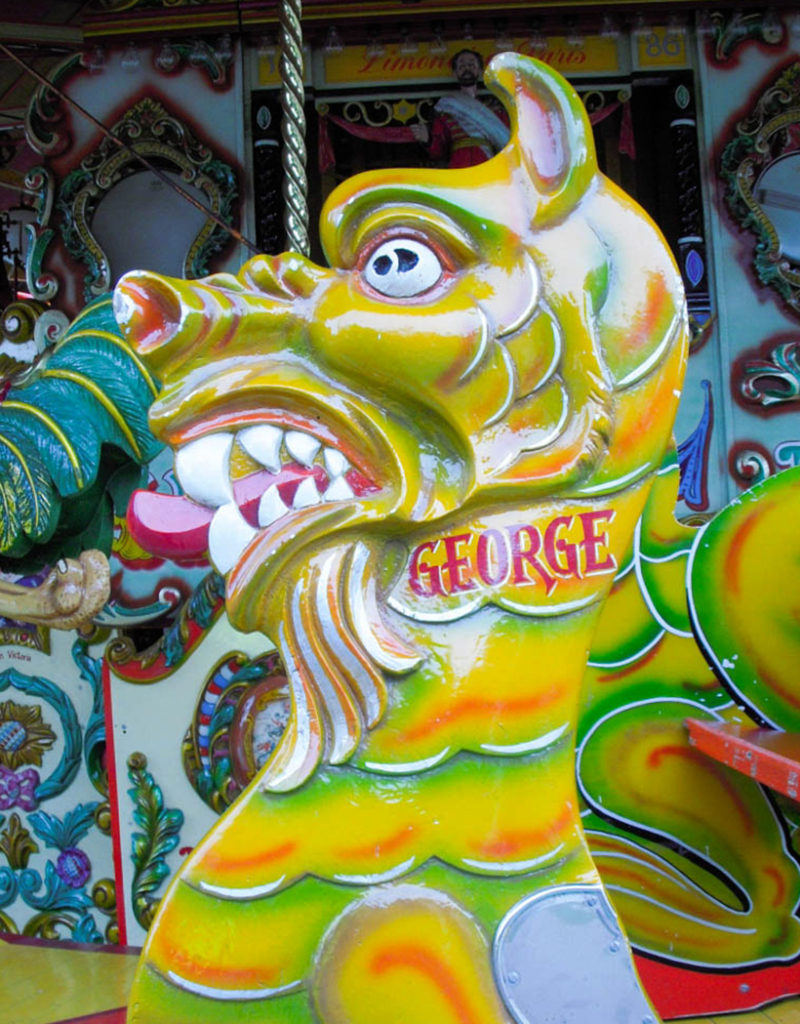
It’s not all horses on the ride, other animals are there, too, as well as bench seats which are equally well decorated.
Ian and Gary were certainly excited about buying Jimmy’s gallopers; they knew that it was a great set before even seeing it, as Jimmy is an expert at galloper restoration. The mounts were so well decorated, the horses with carvings that matched the rounding boards, with an eagle and a serpent. But it was the fact that the animals were carved to a high standard – on both sides – that really caught Ian and Gary’s attention; these were expensive horses. Often it’s only the outer side of the horse – the side that can be easily seen – which is highly carved; the inner sides are often much more plain. But the mounts on this ride were carved on both sides.
The question then was what to do with the gallopers that had come from Holland? So, Ian made a call to showman, John Warrington from Malton, who’d also been interested in the Walker set when it was put up for sale. “I gave him a call and offered them to him,” Ian continued. The answer was a resounding yes, so the gallopers moved to North Yorkshire, where they’re still operating today.
Further restoration
While still travelling Frank Lythgoe’s gallopers, they had to complete the restoration on their own set, which included re-boilering the centre engine, finishing the platforms and steps plus making new shutters. Then Ian and Gary set about creating the transport for the ride. The Savage set came with two trailers and a lorry, so they bought an eight-wheeler lorry for it. But a lot of thought went into the design of the interior of the vehicle.
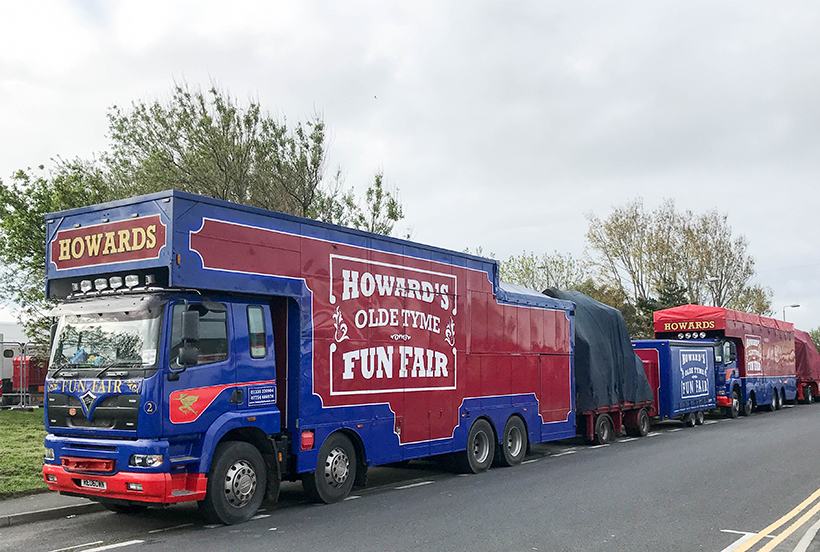
Two Foden lorries transport the gallopers. Here they are seen parked up at Llandudno, for its Victorian Festival.
They did it in such a way that, when unloading the ride, you only had to touch each item once; the improvements in unloading the lorry meant that the ride could be assembled in about three hours. Gary also carried out alterations to the rounding boards to carry the ‘Howard Brothers’ name. He then completed the unfinished decoration on the ride, trying to keep to the style of Neddy Matthews, a famous fairground artist who had started decorating the ride.
Other refinements have been made to the ride over the years, to help with its construction. Years ago, when the ride was being assembled, the centre truck would be pushed on to two, nine-inch gantries to get it to the correct height for the ride to operate. It had to be raised up to allow the mechanism to make the horses go up and down. This could be a tricky operation, with one of the lorries having to manoeuvre the truck precisely on the gantry, so a better method of raising the centre truck was needed.
They built a jack system that wound-out four legs by turning a handle to get the centre to the right height. This was a big step forward but, even that system has now been superseded. Currently they use hydraulics, which are both quicker and safer.
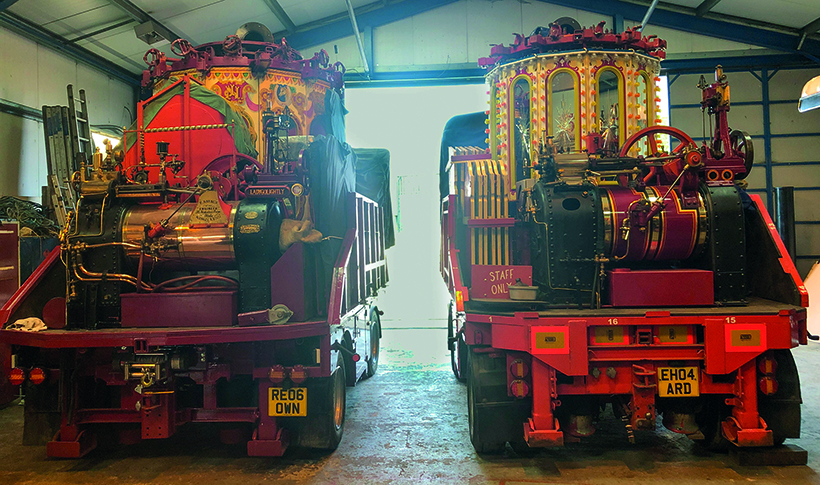
Both centre engines are seen stored in the shed, waiting for their next journey with the two sets of gallopers.
The Howard family still operates the Savage set today, and it certainly works hard each year. During the spring and summer months (from Easter to September) it attends various rallies and events, then spends six weeks (from November to January) providing entertainment in London. That’s the end of the season so, from then until Easter, all rides are checked over, with any maintenance or restoration that’s required being undertaken.
Special project
During each rest period, there’s a special project. This year it was the gallopers’ centre engine trailer, which was rebuilt. “The gallopers are dual-powered, and can run on electricity or steam,” Ian explained, “We have to rely on electricity when the ride is being used indoors, and when we’re in London.”
When the ride isn’t running under its own steam, it’s CWE 787H, a 1974 Scammell Highwayman, that provides the power. This was one of the last ever built with a bonneted cab. As for the Scammell itself, it was new to the legendary haulier, Sydney Harrison, of Sheffield, as an artic unit, and was used on steel work. It was bought in 2008 from a friend, and is occasionally used to generate electricity to power the fairground rides. Named Lord George, it’s been fitted with two Gardner generating sets and a 100-ton winch.

CWE 787H is a 1974 Scammell Highwayman that’s fitted with two Gardner generating sets and a 100-ton winch. Named Lord George, it’s able to provide electricity for the ride. The lorry was new to Sydney Harrison, of Sheffield, as an artic unit, and was used on steel work.
The Savage Gallopers are often seen with the family’s superb, 1920, Fowler showman’s 8hp 18-ton road locomotive (No. 15653) Renown, which was bought in 1979. It’s a well-known engine, which was almost destroyed after being engulfed by fire at Ian and Gary’s workshops, back in 2003. Not to be beaten, though, Renownwas back in steam just 11 months later, and fully-restored after 18 months. It still tours with the gallopers at events up and down the county; a combination not to be missed!
The history of the galloping horse fairground rides can be traced back for hundreds of years, but it was in the 19th century that they began to develop into the rides that are still popular today. Instrumental in the improvement of these rides was Frederick Savage, who was born in the Norfolk village of Hevingham, in 1828. Starting off as a farm labourer, he was later taken on by Thomas Cooper, who was described as a Whitesmith and Machine Maker, before moving to Kings Lynn in 1848, to work for Charles Willett. Upon Willett’s retirement in 1850, Savage set up his own business, which involved making and repairing agricultural implements. Over the following years, he built and developed carts, hoes and steam threshing machines, moving on to the manufacture of early traction engines.
A key role
But it was his involvement with fairground rides that really led him to make his mark. Although he’s not credited with inventing steam-powered roundabouts, Savage was certainly instrumental in their development. Originally, rides were a simple, dobby set, where the animals hung from the top frame, there was no platform or any galloping movement and, although just a basic circular ride, it was the predecessor of the gallopers. These dobby sets had no centre engine, and were much lower to the ground than the later gallopers, because there was no mechanism for the mounts to go up and down.
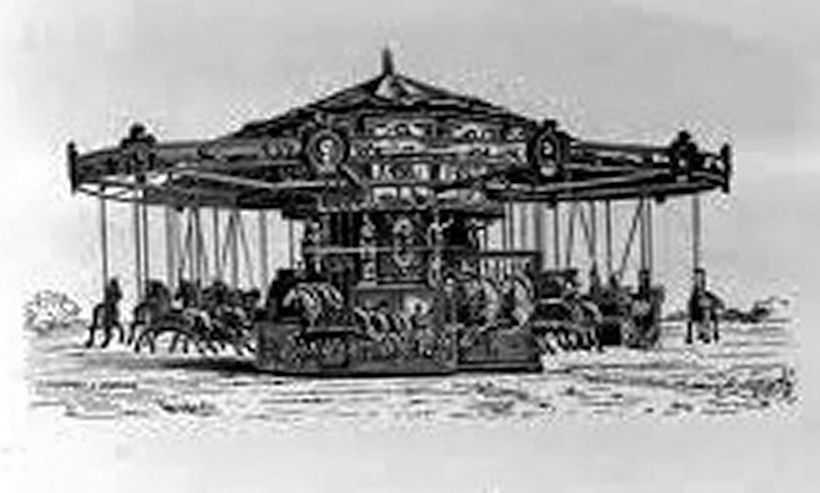
An engraving of a Savage dobby set of gallopers. Much lower to the ground with no platform and mechanism to make the horses go up and down, the Howard Brothers’ set would have looked pretty similar when new, in 1886.
Fredrick Savage was always looking for new innovations, though, and he was key in developing the moving horses of today. In 1885, Savages built its first Platform Gallopers for John Murphy, from Tyneside, on which he fitted gears and offset cranks on the platform, which gave the mounts their up-and-down motion. The most elaborate gallopers had up to 56 horses, which were four abreast and were fitted with Savage’s patent ‘platform slide’. This allowed the mounts to swing out concentrically, as the machine gathered speed.
Each set of gallopers from Savages’ was custom-built; the rides could be a different diameter, with the mounts three- or four-abreast. The design carved on to the mounts could differ as well, meaning that each ride produced could be completely different. Once the steam centre engine arrived, the gallopers started being described as the first ‘white knuckle ride’, and was only suitable for adults. It went so fast that some people were actually thrown off!
The Savage set now owned by Ian and Gary was bought new by Henry Studt, of Carmarthen, who travelled with it around South Wales, followed by his son Jacob, who even took them into Gloucestershire, on occasions. The gallopers then passed to the Whittle family, of Camberley, who operated them in the Surrey area. Around 1896, the gallopers changed hands once again, this time being sold to Alfred Whitelegg, of Cullompton, Devon, who operated them in the south-west of England for many years, before they were bought by Jimmy Noyce and, later, Ian and Gary.
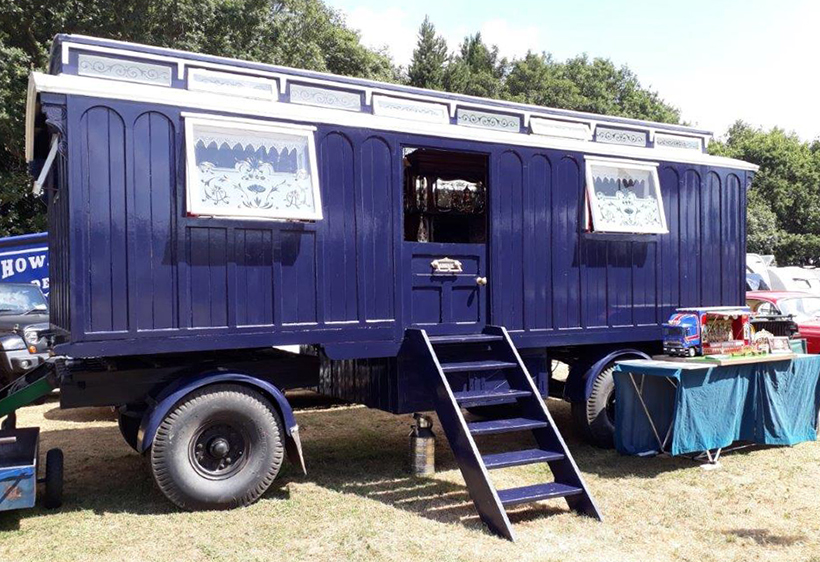
The original, restored Brawshaw living wagon that’s now back with the gallopers. Both were once with Alf Whitelegg.
Wagon search
Back to the time when the gallopers were with Alf Whitelegg, he took possession of a brand new Brayshaw living wagon. This was initially pulled by horses, but it was specially adapted so that it could be transported on a railway wagon when the fair was being moved by train, and was later fitted with a tow bar so that it could be pulled by a showman’s engine. In the late 1950s, the ride and the living van parted company, with little being known about the wagon’s next owners.
Ian and Linda were looking for a living wagon to go with the 1920 Fowler showman’s engine Renown, and were attending a rally when they got chatting with a fellow showman. It turned out that he used to own the actual one that Alf Whitelegg had used with the ride all those years ago. It was tracked-down to Perthshire, where it was being used as a studio by an artist. However, she was unwilling to sell at that time, but said she’d give them first refusal if she ever changed her mind. Well, five years later, Ian and Linda finally received the call they’d been waiting for; the artist was willing to sell the wagon.
With the deal done, the wagon was transported back to Derbyshire, although that, in itself, was a difficult job due to the fragile timbers on the wagon. Eventually, though, they made it back, and an extensive restoration process got underway. Although the interior of the wagon was in good condition, it was a different story on the outside. Rotten timbers in the roof were replaced, and some of the framework had to be renewed, with the outer timber walls being replaced one by one.

The interior of the living wagon, with period stove and wooden panelling.
On show, at last!
By 2012, the rebuild of the wagon was complete. It was painted in its midnight blue livery to match Renown, and the pair were first seen – together with the gallopers – at the Elvaston Steam Rally in 2013.
But it isn’t just Ian and Gary in the family who own fairground rides; Ian’s son, Edward, is heavily involved in the business, too. As well as being a partner in Alton Engineering with Ian, he owns a set of gallopers of his own.
“I started off with a big wheel that was bought from Tony Hall in Cheshire,” Edward said. “I’d known Tony for years, and knew that he was selling his big wheel, and I thought that it would be a good ride to have.” The wheel was bought, restored and painted, with Gary doing the intricate decorating on the ride. The wheel was named the Atlantic Star as it’s an Eli Bridge wheel, made in America. But, more importantly, the Atlantic Star is also a medal awarded by the Royal Navy to the servicemen in WW2, which Edward’s grandfather (Ian and Gary’s father, Ces) was awarded. “This year we’ve been adjusting the mechanism which will allow the wheel to be constructed in a simpler way,” he added.
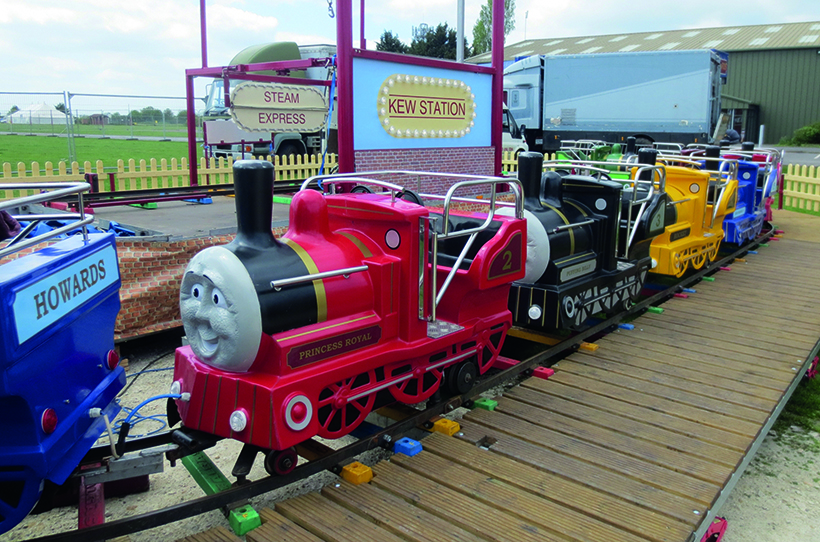
Edward also owns this a juvenile train ride, which is as well-presented as all the other Howard family’s attractions.
Eddie passed his HGV Class 1 license when he was 21, and transports the wheel to shows with an ERF EC14. But, in 2017 he bought a set of gallopers. “They are a Walker set, and have their No. 6 engine on the centre truck,” he said. “They’re reputed to be the last, steam-powered Walker set that’s still travelling the country.” Like Ian and Gary’s Savage set, though, Eddie’s gallopers can be converted to run on electricity, should the need arise. This set doesn’t attend that many rallies, though. “We were getting a lot of requests to attend corporate events as well as weddings,” Ian explained, “so Eddie decided to concentrate on this type of work.”
Other rides owned
As well as the gallopers and big wheel, Eddie also owns a set of swing boats, a juvenile train ride, a very old, juvenile hand-turned dobby set, a circular stall and an adult and juvenile striker; a varied mix, indeed. Eddie’s wife, Claire, is a big help with all of this (she also holds an HGV Class 1 license), and the couple’s two, young children – Charlie and Betty – enjoy the steam and fairground environment as well.
Ian and Gary also own a juvenile ride. “We have a vintage set of Austin cars that operate on a track,” Ian said. Also, in the fairground collection there’s an 1898 Gavioli fairground organ. It’s fitted in the back of a lorry, which the Howard family are custodians of. “It was new to Pat Collins, and was one of two he purchased at that time,” Linda explained. “It was used with his bioscopic picture shows in its early days, and has also been used on a set of gallopers.”
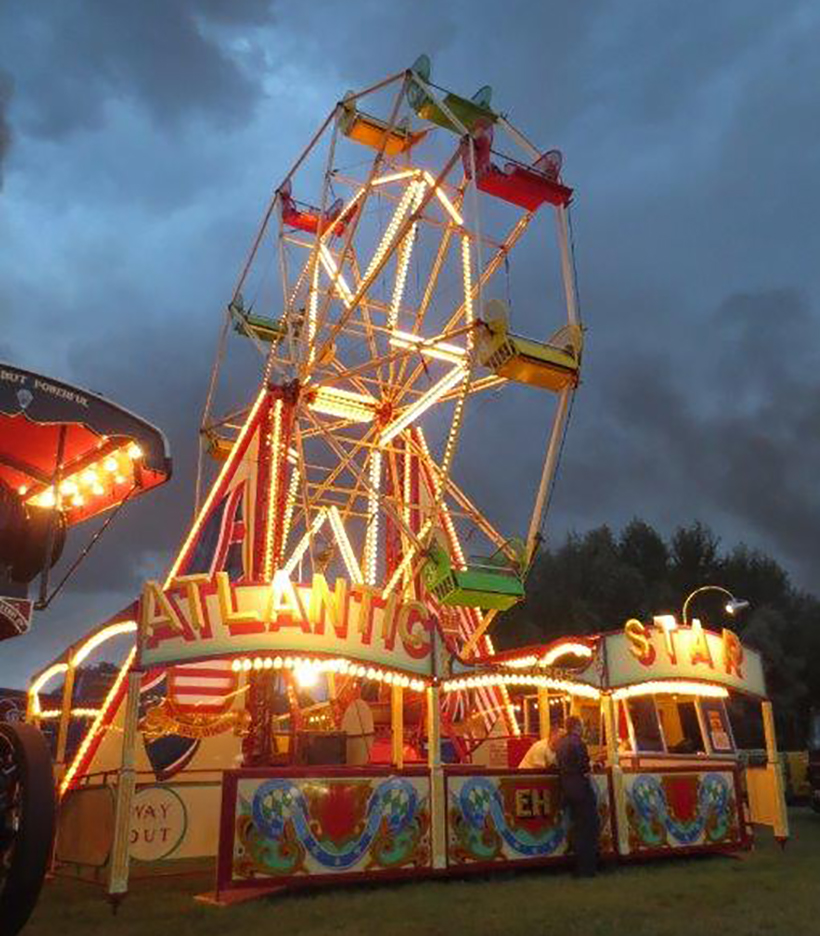
Eddie Howard’s Atlantic Star big wheel is always a popular attraction once the sky starts to darken and the lights come on.
It’s had an eventful life and, in 1926, was reputed to be the first organ to be brought into preservation. “That was with Herbert Slack of New Mills, Derbyshire,” Linda continued. “He donated it to Derbyshire County Council, which exhibited it at various locations around the county, including at the Pavilion Gardens, in Buxton.”
The organ eventually ended up on display at Crich Tramway Village. “Our father, Ces, was interested in this organ, and had tried to buy it a long time ago, without success,” Ian admitted. “Years later, we heard the news that the organ was going out of the county, and felt strongly that it should remain in Derbyshire, after it had been gifted to the council all those years ago.” After a lot of negotiation, they persuaded the council that the organ should be kept in Derbyshire. “The result was that our family has become custodian of the organ for a 99-year period,” Ian said.
Well-travelled tunes
The organ attends shows on a regular basis, around Derbyshire and travelling with the gallopers and other rides. “It’s travelled to The Great Dorset Steam Fair, events at Whitby and many points in between,” Linda said.
During 2020, the Howards – like many other showmen and historic vehicle owners – have had the events and rallies cancelled, but this has not stopped them from working on the rides and vehicles in their collection. The general maintenance, mechanical improvements, painting and twisted brasses re-polishing never stops. Presently in the workshop, Ian and Linda are stripping the paint off the galloper horses, while Gary and his wife, Debbie, are busy decorating the colourful mounts, also renaming a few with the arrival of grandchildren!
Together, they take you back to a time when all fairgrounds were operated by steam, with the excitement that that still generates. You can’t say better than that.
For a money-saving subscription to Old Glory magazine, simply click here



